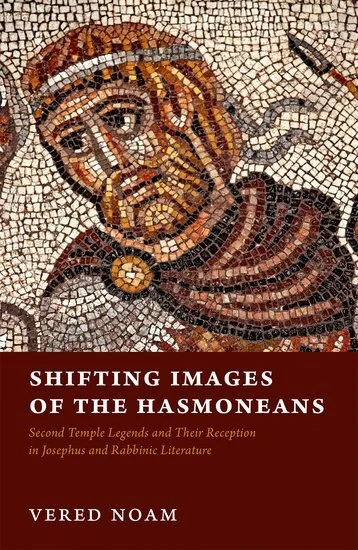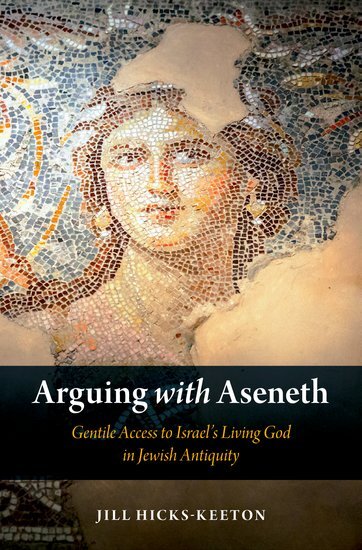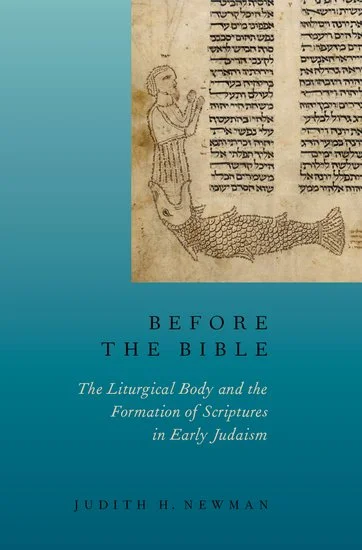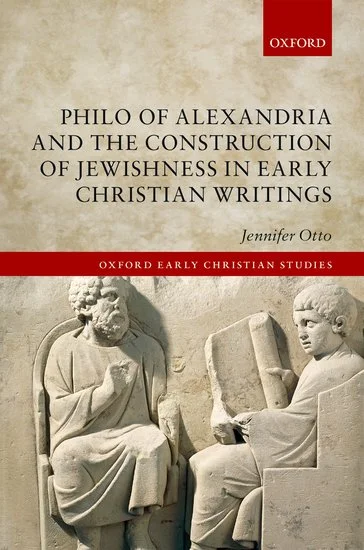To whom are we entrusting ourselves when we follow a particular instructor? To what extent should our will be constrained by a teacher, friend, rabbi, abba? Or is it an image of these figures? What do we make of teaching practices that restrain habits of thinking and opinion? What is the role of Tradition?
Read MoreBook Note | Shifting Images of the Hasmoneans
Noam shies away from firmly positing the existence of a concrete document or text that served as the shared source of rabbinic and Josephan traditions. Rather, she suggests that we conceive of a “pool of traditions,” a shared storehouse of stories and narratives, perhaps containing multiple documents, likely written in Hebrew and Aramaic, to which the rabbis and Josephus both had access.
Read MoreBook Note | Gregory of Nyssa’s Doctrinal Works: A Literary Study
“With this steadily growing interest in Gregory, specialization in particular texts has become the norm. Radde-Gallwitz, having done some of that slow, careful work in his previous books, translations, and articles, argues that there is value in panning back to look at broader patterns, parallels, and divergences.”
Read MoreBook Note | Arguing with Aseneth: Gentile Access to Israel’s Living God in Jewish Antiquity
Gillian Glass reviews Hicks-Keeton’s Arguing with Aseneth: Gentile Access to Israel’s Living God in Jewish Antiquity.
Read MoreBook Note | Synagogues in the Works of Flavius Josephus: Rhetoric, Spatiality, and First-Century Jewish Institutions
This nuance does not help scholars reconstruct detailed synagogue practices, but helps us understand an idea of what synagogues could mean for Jews of the first-century CE.
Read MoreBook Note | Rewriting Masculinity
Kelly Murphy’s Rewriting Masculinity: Gideon, Men, and Might (OUP 2019)offers a fascinating journey through the multiple and layered maculinities of the biblical character Gideon (Judges 6-8), while providing a methodological model for biblical masculinity studies to emulate.
Read MoreBook Note | Pantheon
For students of the rabbis, Roman religion is often thought of as a constant. It is a yardstick against which we measure changing conceptions and ideas of the rabbis. But we would do well to remember that the period in which the rabbis, writ large, were active, is one of the headiest periods of religious change and upheaval in the Roman Empire.
Read MoreBook Note | The Donatist Church in an Apocalyptic Age
Anxiety over the end of time was deeply felt in Late Antiquity. In The Donatist Church in an Apocalyptic Age, Jesse Hoover turns our attention to the role of apocalypse for the Donatists, a currently neglected aspect of their theological and ecclesial vision.
Read MoreBook Note | Paul and the Emergence of Christian Textuality: Early Christian Literary Culture in Context
The thoroughgoing analysis, broad learning, and original theses evinced in this volume are a lodestar for scholars.
Read MoreBook Note | Ancient Prophecy: Near Eastern, Biblical, and Greek Perspectives
With scholarship of the highest caliber, Ancient Prophecy is one of the most complete and authoritative accounts of the prophetic phenomenon in the ancient Eastern Mediterranean, says reviewer William Kelly.
Read MoreBook Note | The Cross: History, Art, and Controversy
In The Cross, Robin Jensen has challenged us to think across discipline and beyond simple periodization, throwing down a cross-shaped gauntlet. I suggest that we pick it up.
Read MoreBook Note | Dancing Lares and the Serpent in the Garden : Religion at the Roman Street Corner
What was the ordinary, nonelite experience of the Roman religious world? How far can we recover the everyday interactions of Romans and their deities in the republican and early imperial periods?
Read MoreBook Note | Before the Bible: The Liturgical Body and the Formation of Scriptures in Early Judaism
Judith Newman. Before the Bible: The Liturgical Body and the Formation of Scriptures in Early Judaism. New York: Oxford University Press, 2018.
The full publication of the Dead Sea Scrolls at the turn of the millennium led to major changes both in in the conception of the Bible’s canonical process and the development of fixed prayer in the Second Temple period. Although both of these shifts have largely developed in separate studies, Newman joins them together in order to demonstrate their intersection with textual authority, pluriformity, and liturgical performance. For Newman, it is important to see early Jewish texts not as developing teleologically towards fixed canonicity by scribes in isolation but as texts used by living communities in embodied practices, which led to additions, reinterpretations, and a dynamic process of scripturalization. In her earlier work, Newman suggested that prayers utilizing biblical tradition played a formative role in the development of early Jewish and Christian liturgies, and this study builds on that observation. Newman is not only asking how prayer uses texts but also how it creates, shapes, and reinforces them.
Newman begins with an overview and critique of scholarship centered on scribalism. While the fact that “canon” and “scripture” are scribal phenomena is an essential observation, Newman calls into question the over-emphasizing of textuality. Whether one examines scribalism via comparative educational models in the ancient Near East, Northwest Semitic epigraphy, or orality, much of this work focuses more on the “scribal hand” rather than aspects of the scribal or liturgical body. Building on a notion of liturgy suggested by Stephan Reif, Newman acknowledges that liturgy is a “constellation of practices” (8) orbiting the study of texts that includes eating, praying, fasting, and wearing amulets. Nevertheless, she chooses to focus on prayer’s relation to texts not only because of its unexplored role in textual composition but also because of its ubiquity in early Judaism. Prayers had many performative possibilities and could influence the neurobiological mechanisms behind an individual’s sense of self as well as reinforce communal models and forms of social cohesion.
The first chapter examines Ben Sira’s use of prayer in the shaping of the scribal self. Not only does Ben Sira mention “rising early” for prayer in the eulogy of the scribe (Sir 39:5-6) in conjunction with other depictions of sages (Wis 7:7), but daily prayer is a key theme throughout the book (cf. 4:26; 18:21; 28:2-5; 34:30-31; 37:15). While Sirach scholarship has largely examined this issue on textual grounds, Newman is more interested in what prayer does and how it functions rhetorically. For this analysis, Newman utilizes the work of neuroscientist Patrick McNamara, who argues that the move from a fragmented to whole self (what McNamara calls the “executive self”) requires a process of decentralization in which one releases control in order to gain greater clarity of mind. According to McNamara, prayer is a decentering strategy, which Newman correlates to Ben Sira’s use of prayer (39:5) moving the sage from a “divided heart” (Sir 1:28) to a “whole heart” (39:35). For Ben Sira, daily confession in prayer fits in a matrix of honor and shame where God disciplines the sage’s body as a pedagogue (Sir 22:27-23:6). Overall, God’s musar/paideia, gives the sage the proper disposition to both acquire wisdom and receive admiration from the assembly.[1] Finally, Ben Sira has a complex textual history with several additions and diverse variant readings spanning from the first century CE to the early Middle Ages.[2] Newman explains that complex history with reference to the liturgical use of Sirach, with readers reflecting and augmenting the text by either adding their own observations, or placing other texts within the book (see Sir 51:13-30). Newman argues that this open process is an enactment of Ben Sira’s pedagogical process in which the student who listens to the living voice of the teacher not only memorizes his teachings but also expands (Sir 21:15) and revises them. Here her interpretation of Sirach as an “open book” and Ben Sira as an authoritative figure builds on the work of Ben Wright and Eva Mroczek who have placed more emphasis on the rhetorical use of Ben Sira as a character rather than as a historical person.[3] While I believe her observation is correct, it will not convince all Ben Sira scholars who tend to read much more continuity and intentionality in the composition of the book than Newman does.
Chapter Two revolves around the re-use of Jeremiah in Daniel 9:4-19 and Baruch 1:15-3:8. Newman argues that Daniel uses Jeremiah to question the efficacy of confessional prayer by making further angelic interpretations necessary to reveal hidden meaning. Baruch diverges from Daniel by reworking the language of Jeremiah alongside Deuteronomy’s prophecy and fulfillment schema. It does so in order to depict the scribe as one who creates and fulfills prophecy in prayer (e.g., God speaks by the hands of the prophets in Bar 2:24). This “passing of the torch” is not simply the result of retooling a confessional prayer Baruch shares with Daniel, but part of the textual tradition of the book itself where the linking of Jeremiah and Baruch in Old Greek makes the latter the heir to the former. While Baruch’s claim to Jeremiah’s tradition in the book’s confessional prayers mirrors the book of Jeremiah’s textual development, Newman is a bit unclear how this textual development relates to actual liturgical practices. Further, Daniel receives a short shrift, leaving the reader curious to fill out the pieces between its liturgical and textual development.
Next turning to Paul’s letters to the Corinthian church, Newman analyzes the liturgical role of the church’s prayer and fundraising on Paul’s behalf. She reframes Paul’s reference to the gift of the churches in Macedonia (2 Cor 8-9) as a rhetorical way to deflate the Corinthian church’s pride in their own gifts. Paul, Newman suggests, situates the Macedonian churches’ gift within a nexus of benefaction and reciprocity that “rekey[s] its significance in egalitarian ways” (84). God is their benefactor, and the Corinthians’ collection is an act of obligation shared with the broader Christian community. Newman suggests that social competition is implicit in Paul’s position as mediator, institutor, and liturgist when he encourages prayers of thanksgiving both in response to the kinship the Corinthian church shares with Jerusalem (2 Cor 9:10-15) and as a means of bringing about Paul’s restoration (2 Cor 1:8-11). Along with the classical model of patronage, Newman connects Paul’s collection to the Jewish concern for almsgiving and his prayer as an appropriation of a typical confessional prayer pattern found in other Second Temple literature. Paul changes the national consciousness of the supplication, however, who has suffered with Israel in exile. Newman contends that Paul no longer needs the exile if he has a new kinship relationship centered on the affliction of Jesus rather than the affliction of Israel (98). For Newman, Paul’s encouragement of communal prayer on his behalf not only reiterates his kinship with the church at Corinth, but it also assumes communal performance of his letters whose ritualization and circulation gave them authority. There is a missed opportunity, however, in not comparing Paul’s appeal to prayer in 2 Corinthians to a similar appeal to pray for Paul’s restoration on behalf of the Jerusalem collection in Romans 15:22-33. Prayer alongside the Jerusalem collection is pervasive in Paul’s writings and may have even influenced the manuscript tradition itself. Manuscripts of Paul’s letters generally begin with those that mention the collection (Romans, 1-2 Corinthians, Galatians) in decreasing order of length. If this grouping is intentional, then it is possible that ritualized praying on behalf of Paul’s collection in Corinth, Rome, and other churches may have been the impetus for grouping these letters thereby generating the first collection (or “canon”) of Paul's Epistles. This theory would further support Newman’s thesis that the interplay between liturgy and textuality often occurs before canonization.[4]
In her fourth chapter, Newman explores textualization and prayer in the Hodayot from the Dead Sea Scrolls. Hodayot scholarship has changed significantly since Stegemann’s reconstruction with new approaches examining their rhetorical role and performative capabilities.[5] Newman’s contribution centers on the maskil and the act of prostration prevalent in the maskil hymns (1QHa 5:12; 20:7). As a teacher, liturgist, and exemplar the maskil could enact through his performance the community’s transformation from human debasement (Niedrigketsdoxologie) to angelic communion. The prostration of the maskil was an enactment of thankfulness for God’s gift of knowledge in response to the confession of sins. Newman considers this act of prostration from two perspectives: the neuropsychological effect on the witnesses of this act in worship and the countercultural act of prostration in prayer. Visual enactments have the capacity to stimulate emotional responses subconsciously, and standing was the normative prayer position in the Hellenistic period. Prostration in a public reading of the Hodayot is debasing and surprising, but it allows the maskil to imitate Moses and reenact the low anthropology of the community. Both external and internal markers of 1QHa suggest to Newman that the Hodayot were utilized for worship (26:10-14, 26) and instruction (9:36-38)—though she curiously ignores the different scribal hands in the text (see col. XX) when she postulates 1QHa as an exemplar. The placement of the maskil in the text in the process of the Hodayot’s redaction only adds to its authoritative status by making the maskil an official authorizer of the collection similar to the attribution of all the hymns to David in the Great Psalms Scroll (11Q5) at the end of its composition. Those who see the maskil as a generalized role anyone could embody may not be convinced with Newman’s assumptions that the maskil is a chief liturgical officer who performed the song’s attributed to him (134). Nevertheless, even if one casts aside this assumption there is still a strong interplay between text, rite, and authorization in the variegated Hodayot collections from Qumran, which demonstrates Newman’s broader insistence that one must examine this interplay as a whole.
Newman’s book is a breath of fresh air and a welcome change of course that squarely places embodiment and performance at the heart of scripturalization. For Newman a text is not simply available for liturgy only after it becomes scripture. Rather, liturgy influences the textual composition process, stimulates textual growth, and creates textual authority before the process of canonization begins. Newman challenges us to imagine this liturgical-textual interplay as a product of biological, ritualized, and communal bodies that experience and utilize texts in a process much more dynamic and multifunctional than scriptoria and scribalism. For Newman scriptural formation and augmentation is an embodied process that requires holistic analysis. Her work is a masterclass on how to interweave complex textual, non-textual, and interdisciplinary data into a succinct, erudite argument. Both scholars of early Judaism and Late Antiquity will benefit from engaging with the questions she raises, as well as her call to zoom out from the “scribal hand” in order to recreate a total body experience.
[1] Newman’s insights here pair nicely with other recent work on this topic particularly her suggestion that body parts have a mind of their own and the need to ritualize the senses in creating the scribal self. Cf. Bradley C. Gregory, “Slips of the Tongue in the Speech Ethics of Ben Sira,” Biblica 93 (2012): 321-39; Gregory Schmidt Goering, “Attentive Ears and Forward-Looking Eyes: Disciplining the Senses and Forming the Self in the Book of Proverbs,” JJS 66 (2015): 242-64; Elisa Uusimäki, “The Formation of a Sage according to Ben Sira,” in Second Temple Jewish ‘Paideia’ in Context, ed. Jason M. Zurawski and Gabriele Boccaccini, BZNW 228 (Berlin: de Gruyter, 2017), 59-70.
[2] For the complex textual history of Ben Sira, see Jean-Sébastien Rey and Jan Joosten, eds., The Texts and Versions of the Book of Ben Sira: Transmission and Interpretation (Leiden: Brill, 2011) and the forthcoming entries in Arim Lange and Mattias Henze, eds., Textual History of the Bible.
[3] Benjamin G. Wright, “Ben Sira on the Sage as Exemplar,” in Praise Israel for Wisdom and Instruction: Essays on Ben Sira and Wisdom, the Letter of Aristeas and the Septuagint, JSJSup 131 (Leiden: Brill, 2008), 165-82; Eva Mroczek, The Literary Imagination in Jewish Antiquity (Oxford: Oxford University Press, 2016).
[4] For this argument, see David Trobisch, Paul's Letter Collection: Tracing the Origins (Bolivar, MO: Quiet Waters Publications, 2001).
[5] Cf. Carol A. Newsom, The Self As Symbolic Space: Constructing Identity and Community at Qumran, STDJ 52 (Leiden: Brill, 2004); Angela Harkins, Reading with an “I” to the Heavens: Looking at the Qumran Hodayot through the Lens of Visionary Traditions, Ekstasis 3 (Berlin: de Gruyter, 2012); Trine Bjørnung Hasselbalch, Meaning and Context in the Thanksgiving Hymns: Linguistic and Rhetorical Perspectives on a Collection of Prayers from Qumran, SBLEJL 42 (Atlanta: SBL Press, 2015).
Book Note | Enslaved Leadership in Early Christianity
Katherine Shaner’s book is a careful and rigorous examination of the extent of enslaved leadership in antiquity as well as the prevalence of scholarly erasure of that leadership.
Read MoreWriting on the Wall: Graffiti and the Forgotten Jews of Antiquity
Jillian Stinchcomb reviews Karen Stern’s Writing on the Wall: “Stern’s work synthesizes archaeological and material histories across the Mediterranean, bringing together discussions of the lived realities of a Jews from socio-economic perspectives that are under-represented in rabbinic and other (elite) literary Jewish texts.”
Read MorePhilo of Alexandria and the Construction of Jewishness in Early Christian Writings
Sheldon Steen reviews Jennifer Otto’s Philo of Alexandria and the Construction of Jewishness in Early Christian Writings: “The epithets he is given betray at once the utility and liability of Philo for Christian discourses of identity because of how he is depicted as never fully one of “us” nor one of “them.”"
Read MoreBook Note | Mothers in the Jewish Cultural Imagination,
Sari Fein reviews the edited volume, Mothers in the Jewish Cultural Imagination: “What other images of mothers exist in the Jewish cultural imagination? And, what do those images reveal about wider ideas of gender and family in Jewish culture?”
Read MoreBook Note | Acts of the Apostles and the Rhetoric of Roman Imperialism
In Acts of the Apostles and the Rhetoric of Roman Imperialism, Drew Billings places Emperor Trajan and the triumphal Column erected to honor his reign into conversation with the New Testament’s Acts of the Apostles.
Read MoreBook Note | Pirqei deRabbi Eliezer: Structure, Coherence, Intertextuality.
Yoni Nadiv reviews Katharina Keim’s Pirqei deRabbi Eliezer: Structure, Coherence, Intertextuality: “In the absence of a critical edition, Keim argues that the literary descriptive project she undertakes is not only possible absent a critical edition but is a prerequisite for preparing one.”
Read MoreBook Note | Patristic Theories of Biblical Interpretation: The Latin Fathers
The selection of ancient authors covered in this volume is governed by the explicit criterion that the ancient author must discuss something that may be surmised to be a “theory” of biblical interpretation. That is, the articles included do not simply survey how exegesis was practiced amongst Latin authors in late antiquity. Rather, they concern themselves specifically with Latin authors who articulated their hermeneutical method.
Read More


















